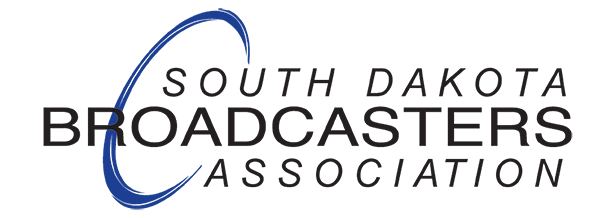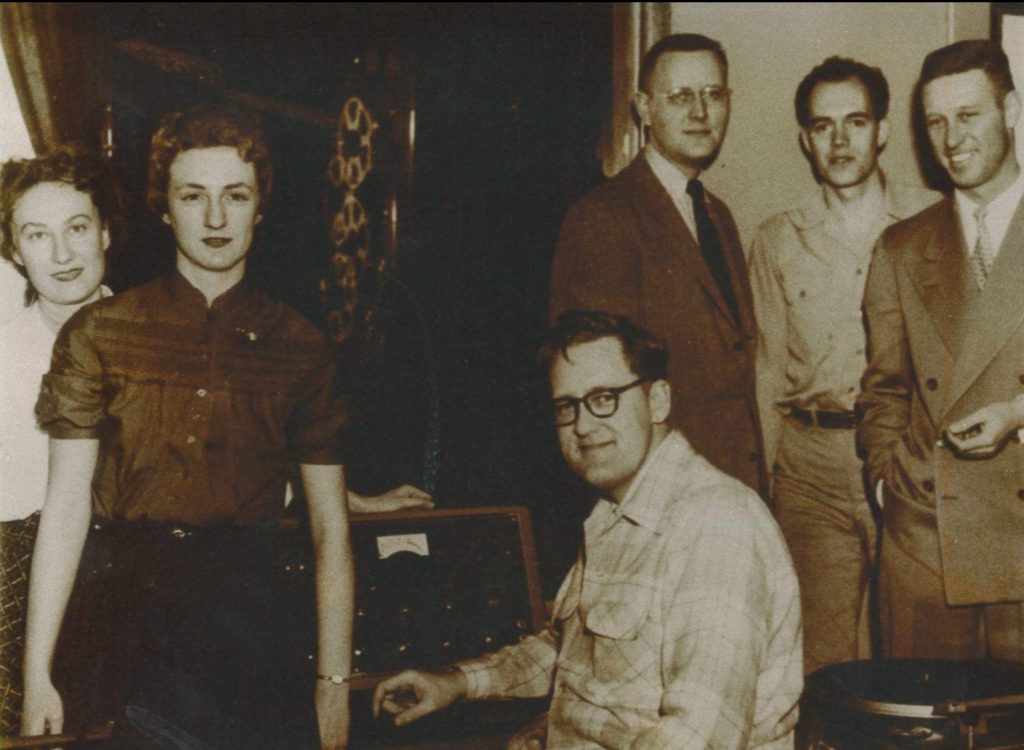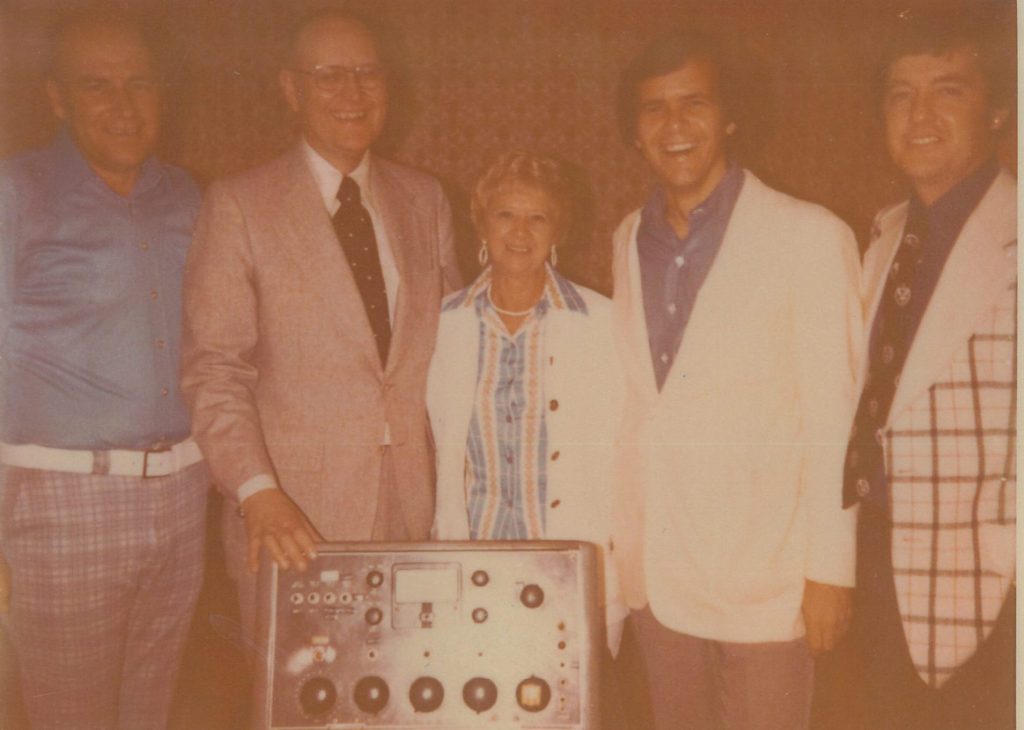Industry History
Broadcast Pioneers

The first KGDA “studio” was in the rear of the Home Auto Company garage at 329 Third Street, Dell Rapids. No official station records could be found, but the station probably went on tile air in 1925 or 1926. It operated from the garage for more than a year. after which Nelson built a second studio in a building across the street. Dieson recalled that after one of his commercials he received a response from a resident of Willmar, Minn.. a community approximately 120 miles northeast of Dell Rapids. Nelson’s niece, Mrs. Loyal Erikson, recalls that her uncle went on the air for a test broadcast at two o’clock one morning, and asked for listener response. One card came from California, indicating that KGDA had excellent range.
James Nelson’s brother, David Nelson, doesn’t recall that the station did much broadcasting during the week, but does recall that the station had very popular live music programs on Sunday evenings. Among the performers were “The Happy Jack Band” from Yankton, Max Nawroth, an accordionist from Colton, a quartet of gospel singers, and a girl singer known as the “Lark of the Dells.” In 1930, Nelson closed the station in Dell Rapids and moved to Mitchell, where he engineered another early station. After about a year in Mitchell he returned to Dell Rapids and opened a radio sales and service business. He died April 7, 1947.
Alfred Nelson built the pioneer station in Oldham. Lou Loesch, 84 year-old resident of Oldham, may have been one of the first sportscasters in South Dakota. He recalls that the Oldham station was built “before the bank closings”—probably 1928. He doesn’t recall the station’s power or frequency. but the call letters were KDGY. It was financed by two brothers, John and William Loesch, who owned the Oldham Pharmacy. The first studio was in the rear of the pharmacy. The motivation for building the station probably was twofold—to provide a radio service for the people of the area and to promote the sale of radio receivers. The Loesch brothers sold Majestic radios from their drugstore. Lou says that Alfred Nelson worked in a local hardware store and was “the best mechanic we ever had in this cockeyed town.”
As to programming. Loesch says the station went on the air about 2 o’clock each afternoon, and signed off around 6 p.m. unless the local high school had a basketball game scheduled. The station broadcast most of the high school games. both at home and away. Lou did the play-by-play announcing of the out-of-town games and co-owner of the station, William Loesch, announced the home games. Lou had this to say about other programming:
“A bunch of Swedes out east of town had an orchestra two violins. a banjoist and a drummer. They used to come in and play. They were called the Erickson Brothers Orchestra. We also played a lot of music records—polkas, mostly—and my brother used to play the piano once in a while. I don’t recall that we had any news programs. The only advertiser on the station was the drug store, except for times when some of the farmers would go broke and advertise an auction sale.”
At the time that KDGY was on the air—from about 1928 to 1930—the population of Oldham was about 500.
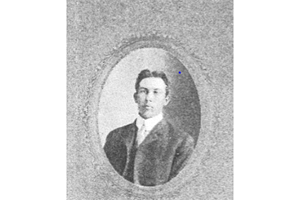
Some of the most interesting radio stations in South Dakota are those that went out of business. A number of small communities—Dell Rapids, Oldham. Brookings. Mitchell, and Huron—had early radio stations in this category. The first radio station in Sioux Falls, WFAT, operated for only two years—from 1924 to 1926. Brookings had a station, KGCR, from June 7, 1927, until March, 1929 when it was moved to Watertown. In both Huron and Mitchell there were radio stations from 1930 to about 1936, when they ceased operation. New stations have been established in Brookings, Huron, and Mitchell to replace those which were closed.
James R. Nelson, KGDA, Dell Rapids.
Two of the earliest commercial radio stations in South Dakota were “hand made” by two cousins, both of whom were excellent auto mechanics. The men were James R. Nelson, who put a station on the air in Dell Rapids in the mid-20’s, and his second cousin, Alfred Nelson, who built a station a few years later in Oldham, a community of about 500 population a few miles southwest of Arlington. James Nelson was born in Trent, S. D., August 14, 1879. When he was 32 (1911) he moved to Dell Rapids and opened the Home Auto Company in partnership with J. T. Cone. They had the dealership for the Apperson, Hupmobile, and Overland
automobiles. Harry T. Dieson, who operated a department store in Dell Rapids, recalls that Nelson was a “darn good mechanic,” and remembers the beginnings of the radio station. Dieson, in fact, may have been one of the first merchants in the state to go on the air to advertise his store products in his own voice..
The call letters of the Dell Rapids station were KGDA, and Nelson would identify the station as follows: “This is KGDA Kind Greetings; Dells Announcing.”
Central South Dakota
The broadcast pioneers in the central part of the state were Dana McNeil, a railway conductor, and his wife, Ida A. McNeil, of Pierre. McNeil started ex-perimenting in “ham radio” prior to the first World War, and received a U. S. Department of Commerce Class 5 (Special Amateur) license on June 6, 1916. The original call letters were 9LP. These later were changed to 9CLS, and in 1927 to KGFX. After the McNeils were married (1921) Mrs. McNeil learned to operate the amateur radio equipment so she could chat with her husband while he was on his train rims to and from Rapid City. At this time the studio was in the McNeil home at 504 West Pleasant Drive, Pierre. In 1923 the McNeils moved to 203 West Summit Avenue, and again operated the radio station from their home. KGFX continued to be based in their residence, with a power of 200 watts, until 1962.
After Dana McNeil died in 1936, Mrs. McNeil continued as the station owner and licensee. She became well-known in her home area and nationally. She was featured in an article in Coronet Magazine (March, 1947) and received the McCall Magazine “Golden Mike” award in 1956. Mrs. McNeil’s style was warm and friendly. One of the most useful and appreciated programs of the station included a feature of Public Service Announcements, given in third person as news notes, taking into account the rules of the F.C.C. against point-to-point contact. The article in Coronet Magazine gives this example:
During World War II, a Pierre girl was planning to marry a soldier in a home wedding. At the last moment, the soldier’s leave was shortened to such an extent that he couldn’t get to Pierre for the wedding. The plans were changed and; the bride-to-be was to take a train to her fiance’s army base to be married there. Her parents took her from their ranch home to the railroad station in Pierre, and on arrival there she realized she had left some of her apparel at home. Her mother had the solution call Ida McNeil. Mrs. McNeil broadcast the following news story. “Gladys Schmidt arrived in Pierre this morning, but left the slip to her wedding gown at home.” This “news announcement” saved the day for an apprehensive Gladys Schmidt. Her brother, at home on the ranch, heard the announcement, went into his sister’s room, found the slip, and drove the 40 miles to Pierre to deliver the property to his sister just as the train was about to pull out. At a period when many rural areas of South Dakota had no or few telephones, Mrs. McNeil’s radio station provided valuable services. She established a policy of calling the local hospital each day for routine news of admissions, births, releases, and deaths. An announcement stating that Bill Jones would be released from St. Mary’s at 3 o’clock that afternoon was a clue to Mrs. Jones to come in from the ranch to pick him up. When ranchers were stranded in town by blizzards, Mrs. McNeil would broadcast their names so their families would not expect them home until the weather cleared.
McCall’s Magazine, honoring Mrs. McNeil in 1956, stated: “Station KGFX, Pierre, South Dakota, which for the past 41 years has been synonymous with the name of its owner, manager, and broadcaster, Ida A. McNeil, winner of McCall’s Award as ‘the executive performing the greatest service to her community?” Mrs. McNeil has two sons, Col. Robert James McNeil, a West Point graduate and career army officer, and Richard Dana McNeil, a graduate of the Naval Academy, now professor of electrical engineering at the South Dakota School of Mines and Technology. She sold KDFX in 1962.
Dr. Koren, a physician, was instrumental in starting other early stations in Huron, Watertown, and Mitchell. He also assisted in the activation of KABR. Aberdeen, which went on the air in September, 1933. There was a station in Watertown as early as 1929. This was KGCR, which had been moved to Watertown from Brookings. The Watertown license was issued on April 29, 1929 under call letters KGCR. These were changed to KWTN in 1934, but this station’s license renewal application was denied and the call letters deleted by the FCC as of November 6, 1939. The oldest Watertown station in current operation is KWAT. The construction permit for this station was issued on Decemher 22, 1939, with 250 watts of power at 1210 kilocycles. On January 1, 1950, KWAT went to 1000 watts at 950 kilocycles.
KORN, Mitchell, and KIJV, Huron, both went on the air in 1947. A year later, KSDN started operating in Aberdeen, being the second station in that city. Almost all of the communities over 3,000 population now have standard AM stations. These include Brookings, Lemmon,
Madison, Mobridge, Redfield, Vermillion, and Winner. Two communities Yankton and Pierre have two stations. The second Yankton station, KYNT, started operating in 1955. The second station in Pierre, KCCR, went on the air in 1959.
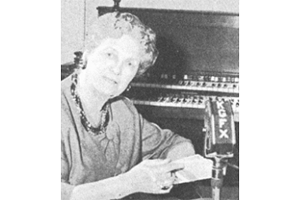
The broadcast pioneers in the central part of the state were Dana McNeil, a railway conductor, and his wife, Ida A. McNeil, of Pierre. McNeil started ex-perimenting in “ham radio” prior to the first World War, and received a U. S. Department of Commerce Class 5 (Special Amateur) license on June 6, 1916. The original call letters were 9LP. These later were changed to 9CLS, and in 1927 to KGFX. After the McNeils were married (1921) Mrs. McNeil learned to operate the amateur radio equipment so she could chat with her husband while he was on his train rims to and from Rapid City. At this time the studio was in the McNeil home at 504 West Pleasant Drive, Pierre. In 1923 the McNeils moved to 203 West Summit Avenue, and again operated the radio station from their home. KGFX continued to be based in their residence, with a power of 200 watts, until 1962.
After Dana McNeil died in 1936, Mrs. McNeil continued as the station owner and licensee. She became well-known in her home area and nationally. She was featured in an article in Coronet Magazine (March, 1947) and received the McCall Magazine “Golden Mike” award in 1956. Mrs. McNeil’s style was warm and friendly. One of the most useful and appreciated programs of the station included a feature of Public Service Announcements, given in third person as news notes, taking into account the rules of the F.C.C. against point-to-point contact. The article in Coronet Magazine gives this example:
During World War II, a Pierre girl was planning to marry a soldier in a home wedding. At the last moment, the soldier’s leave was shortened to such an extent that he couldn’t get to Pierre for the wedding. The plans were changed and; the bride-to-be was to take a train to her fiance’s army base to be married there. Her parents took her from their ranch home to the railroad station in Pierre, and on arrival there she realized she had left some of her apparel at home. Her mother had the solution call Ida McNeil. Mrs. McNeil broadcast the following news story. “Gladys Schmidt arrived in Pierre this morning, but left the slip to her wedding gown at home.” This “news announcement” saved the day for an apprehensive Gladys Schmidt. Her brother, at home on the ranch, heard the announcement, went into his sister’s room, found the slip, and drove the 40 miles to Pierre to deliver the property to his sister just as the train was about to pull out. At a period when many rural areas of South Dakota had no or few telephones, Mrs. McNeil’s radio station provided valuable services. She established a policy of calling the local hospital each day for routine news of admissions, births, releases, and deaths. An announcement stating that Bill Jones would be released from St. Mary’s at 3 o’clock that afternoon was a clue to Mrs. Jones to come in from the ranch to pick him up. When ranchers were stranded in town by blizzards, Mrs. McNeil would broadcast their names so their families would not expect them home until the weather cleared.
McCall’s Magazine, honoring Mrs. McNeil in 1956, stated: “Station KGFX, Pierre, South Dakota, which for the past 41 years has been synonymous with the name of its owner, manager, and broadcaster, Ida A. McNeil, winner of McCall’s Award as ‘the executive performing the greatest service to her community?” Mrs. McNeil has two sons, Col. Robert James McNeil, a West Point graduate and career army officer, and Richard Dana McNeil, a graduate of the Naval Academy, now professor of electrical engineering at the South Dakota School of Mines and Technology. She sold KDFX in 1962.
Dr. Koren, a physician, was instrumental in starting other early stations in Huron, Watertown, and Mitchell. He also assisted in the activation of KABR. Aberdeen, which went on the air in September, 1933. There was a station in Watertown as early as 1929. This was KGCR, which had been moved to Watertown from Brookings. The Watertown license was issued on April 29, 1929 under call letters KGCR. These were changed to KWTN in 1934, but this station’s license renewal application was denied and the call letters deleted by the FCC as of November 6, 1939. The oldest Watertown station in current operation is KWAT. The construction permit for this station was issued on Decemher 22, 1939, with 250 watts of power at 1210 kilocycles. On January 1, 1950, KWAT went to 1000 watts at 950 kilocycles.
KORN, Mitchell, and KIJV, Huron, both went on the air in 1947. A year later, KSDN started operating in Aberdeen, being the second station in that city. Almost all of the communities over 3,000 population now have standard AM stations. These include Brookings, Lemmon,
Madison, Mobridge, Redfield, Vermillion, and Winner. Two communities Yankton and Pierre have two stations. The second Yankton station, KYNT, started operating in 1955. The second station in Pierre, KCCR, went on the air in 1959.

Mrs. Ida A. McNeil, KGFX, Pierre
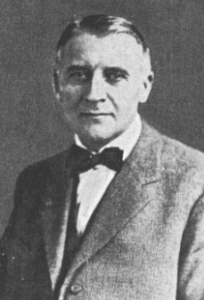
Dana McNeil, KGFX, Pierre
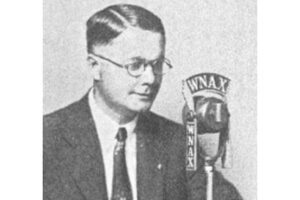
The small town of Yankton, in the southeast corner of South Dakota, spawned one of the most distinctive and most spectacular radio stations in the United States. The station was WNAX. This is the station which at one time refused to sell air time to merchants who wanted to advertise; the station which was primarily responsible for the success of a young and hungry Lawrence Welk; the station which pioneered in direct sales to customers on a mail-order basis; a station which as early as 1928 had its own concert orchestra acclaimed as one of the finest in the country ; and a station which helped elect one of its managers to a two-term seat in the U. S. Senate. Two men fresh out of army service in the first World War—were responsible for starting WNAX. They were E. C. “Al” Madson, and Chan Gurney, whose father was president of the Gurney Seed and Nursery Company. These two men started “playing around” with radio in 1921. Madson had studied engineering at the University of Minnesota, and following his war service returned to Yankton to start the Dakota Radio Apparatus Company, distributors of Crosley radios. A close friend was Chan Gurney, who was working for his father and uncles in the nursery business. The two men developed a rather crude broadcasting station by combining some Condensers, batteries, and wires strung across the roof of Madson’s warehouse on Walnut Street just north of Third Street. For a microphone, Madson used a “morning glory horn” which had been removed from an Edison phonograph. This first studio was one floor above a small restaurant. Madson and Gurney placed a test radio receiver in the restaurant one evening while working on their transmitter, a while later, using their improvised microphone, they ordered sandwiches and coffee. The cafe owner came up a few minutes later to deliver their order, and this was their first evidence that the contraption worked.
The station was first licensed in November, 1922, with Madson as president and chief engineer. The station sold no air time, so had no revenues. After about three months on the air, WNAX ceased operations and put the equipment in storage. Madson went back to his regular business, and Gurney went on to become secretary and treasurer of the seed and nursery company. WNAX might never have been revived except for an incident which occurred in 1927. The Henry Field Seed Company, strong competitors of the Gurney Company, had purchased time on KFNF, Shenendoah, Iowa. Field went on the air each day to talk about the merits of his grain seeds, and the farmers bought. Gurney sales were deteriorating, and Chan Gurney thought that their competitor’s use of radio was the reason. He went to his father and suggested that the company buy Al Madson’s license and do the same thing. The Gurneys paid Madson $2,000 for the license, with its frequency of 570 kilocycles. The contract also called for the Gurney company to buy any new equipment which might be needed and that Madson was to be responsible for setting up the studio and transmitter. The studio was built in the home of D. B. Gurney. The station returned to the air in 1927—probably in March or April. Chan Gurney, later to become U. S. Senator from South Dakota, was the station announcer all day and every day for the first few weeks. All programming was live, with local singers, musicians, and guitar players. All of the advertising messages concerned Gurney products.
The station was an immediate success, and the Gurney business curve started upward again. By the fall of 1928, the station had a staff of 25 to 30 salaried musicians. Gurney’s Concert Orchestra received a plaque from Radio Digest magazine as the most popular radio orchestra in America in 1927-28. In addition to the staff musicians, WNAX gave air time to traveling groups of musicians who passed through the area on small-town dance dates. One of these five-piece orchestras was headed by a young accordionist from North Dakota named Lawrence Welk. He played often on WNAX, and his appearances on the station gave him the public exposure he needed to get well-paying dance jobs in the Middle West. The station’s power gradually was increased though the purchase of a 1,000-watt Western Electric transmitter in 1928. The station went to 5,000 watts in 1933.
WNAX in this early period was a “mail order” station. The staple business continued to he seeds and plants, but the company also advertised and sold, through the mails, numerous other products for the farm and home, including baby chicks, hog feeds, overcoats, overshoes, radio sets, Gurney tires and automotive supplies, and many other items. In addition, the company developed the WNAX Gasoline brand name, and at one time had 578 gasoline stations throughout the upper Midwest. During the noon hour each day, D. B. Gurney would go on the air to chat with farmers about crop conditions, farm economics, and farm politics. He also would editorialize on these matters, expressing his personal viewpoint. For example, he was dead set against the manufacture and sale of oleomargarine, which competed against the butter being produced by dairy farmers in his listening area. This editorial campaign was a success, as indicated by the fact that the South Dakota legislature passed a special tax on the sale of oleomargarine in the state. The law has since been reversed.
The mail order concept of broadcasting remained in effect at WNAX until the fall of 1932. At that time, a disagreement developed in the family-owned business relative to the sale of air time to other merchants and services. Chan Gurney wished to continue the release of CBS network programs, but retain most of the other broadcast hours for the advertising of seed and nursery products. His father, D. B. Gurney, who was company president, felt the company should serve other com-mercial interests. As a result of this difference of opinion, Chan Gurney sold his interests in the family enterprises and went into private business and later politics. He served as U. S. Senator from South Dakota from 1939 to 1951. During the following 14 years—from 1951 to 1965—he was a member of the Civil Aeronautics Board in Washington. He now is retired and living in Yankton. The Gurney company continued to operate WNAX until November 1st, 1938. when the station was sold to the Cowles interests of Des Moines, Iowa.
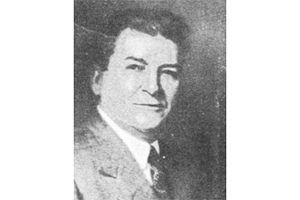
The first radio station in Sioux Falls was WFAT, built and owned by the Sioux Falls Argus-Leader in 1924. About a year after this station went. on the air, the newspaper donated the station and all its equipment to Columbus College, a parochial school in the city. The college (no longer in existence) operated the station until 1926, when it went off the air. The oldest continuously operated station in Sioux’ Falls is KSOO. It went on the air in 1926 from studios located in the Manchester Biscuit Company plant; now the site of Raven Industries. The original owners were B. M. “Bram” McKenzie, who had the distributorship for Crosley radios, and Cy Rapp. The station had 100 watts of power, but later increased its output to 2500 watts and in 1951 to 10 kilowatts.
Since 1927, KSOO has been managed by Joseph Henkin and his son, Morton H. Henkin. The elder Henkin went to Sioux Falls in 1927 after purchasing a major interest in the station. Prior to that, he operated a clothing store and amusement park in Madison, S. D., and had been a city commissioner there. In 1937, Joseph Henkin and a partner, Sam Fantle, started KELO, the city’s second radio station. At that time, KSOO and KELO operated joint studios at 315 South Phillips Avenue. In April, 1946, Fantle bought controlling interest in KELO and started construction of new studios at the corner of Eighth and Phillips. The new studios were completed in May, 1947.
KSOO and KELO were the only radio stations in the city until KNWC went on the air in 1946. KISD was the next station, inaugurating service on May 6, 1948. KSOO and KELO also were the pioneering television stations in the eastern part of the state. Joe Floyd of Sioux Falls, and Eddie Ruben and N. L. Bentson, both of St. Paul, Minn., purchased KELO (the radio station) on May 1, 1952. Ruben and Floyd had been in the theater business in Minnesota and South Dakota. Bentson was operating WMIN radio in St. Paul. Floyd was named president of Midcontinent Broadcasting Company, the new owners of KELO-AM.
Soon after the change of ownership of KELO radio, Midcontinent applied to the Federal Communciations Commission for permission to construct a television station. The construction permit was granted on November 19, 1952, for KELO-TV, channel 11. The station went on the air on May 19, 1953, providing television programs for homes in South Dakota, northeastern Nebraska, and the adjoining areas of Iowa and Minnesota. KELO-TV was one of the few stations in the nation to go on the air without TV cameras. At the outset, the station used only syndicated films. All local programs were produced on 16 millimeter film. In the next four years, Midcontinent built two satellite stations to serve additional areas of eastern and northern South Dakota. KDLO-TV went on the air in September, 1955, in Florence, to serve Watertown and other communities in the northeastern corner of the state. The second satellite, KPLO-TV, started operating on channel 6 from Reliance, in July, 1957. The stations carry CBS programming. KSOO-TV brought NBC programming to South Dakota, with inauguration of service on channel 13 starting July 31, 1960. The only other commercial stations in the eastern part of the state are KCOO-TV (originally KXAB-TV) in Aberdeen, and KORN-TV, Mitchell. John Boler, a North Dakotan, put KXAB on the air November 28, 1958, with studios in Aberdeen and transmitter at Conde, SD. This station was sold to KSOO-TV in 1969. Its call letters were then changed to KCOO and it became a satellite of KSOO, Sioux Falls.
Ray V. Eppel, president of the Mitchell Broadcasting Association, owners of KORN radio, started KORN-TV. This station, carrying ABC programming, went on the air June 12, 1960.
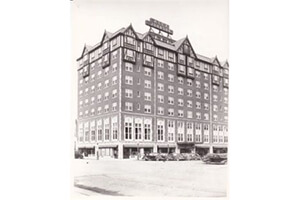
The first radio station in Sioux Falls was WFAT, built and owned by the Sioux Falls Argus-Leader in 1924. About a year after this station went. on the air, the newspaper donated the station and all its equipment to Columbus College, a parochial school in the city. The college (no longer in existence) operated the station until 1926, when it went off the air. The oldest continuously operated station in Sioux’ Falls is KSOO. It went on the air in 1926 from studios located in the Manchester Biscuit Company plant; now the site of Raven Industries. The original owners were B. M. “Bram” McKenzie, who had the distributorship for Crosley radios, and Cy Rapp. The station had 100 watts of power, but later increased its output to 2500 watts and in 1951 to 10 kilowatts.
Since 1927, KSOO has been managed by Joseph Henkin and his son, Morton H. Henkin. The elder Henkin went to Sioux Falls in 1927 after purchasing a major interest in the station. Prior to that, he operated a clothing store and amusement park in Madison, S. D., and had been a city commissioner there. In 1937, Joseph Henkin and a partner, Sam Fantle, started KELO, the city’s second radio station. At that time, KSOO and KELO operated joint studios at 315 South Phillips Avenue. In April, 1946, Fantle bought controlling interest in KELO and started construction of new studios at the corner of Eighth and Phillips. The new studios were completed in May, 1947.
KSOO and KELO were the only radio stations in the city until KNWC went on the air in 1946. KISD was the next station, inaugurating service on May 6, 1948. KSOO and KELO also were the pioneering television stations in the eastern part of the state. Joe Floyd of Sioux Falls, and Eddie Ruben and N. L. Bentson, both of St. Paul, Minn., purchased KELO (the radio station) on May 1, 1952. Ruben and Floyd had been in the theater business in Minnesota and South Dakota. Bentson was operating WMIN radio in St. Paul. Floyd was named president of Midcontinent Broadcasting Company, the new owners of KELO-AM.
Soon after the change of ownership of KELO radio, Midcontinent applied to the Federal Communciations Commission for permission to construct a television station. The construction permit was granted on November 19, 1952, for KELO-TV, channel 11. The station went on the air on May 19, 1953, providing television programs for homes in South Dakota, northeastern Nebraska, and the adjoining areas of Iowa and Minnesota. KELO-TV was one of the few stations in the nation to go on the air without TV cameras. At the outset, the station used only syndicated films. All local programs were produced on 16 millimeter film. In the next four years, Midcontinent built two satellite stations to serve additional areas of eastern and northern South Dakota. KDLO-TV went on the air in September, 1955, in Florence, to serve Watertown and other communities in the northeastern corner of the state. The second satellite, KPLO-TV, started operating on channel 6 from Reliance, in July, 1957. The stations carry CBS programming. KSOO-TV brought NBC programming to South Dakota, with inauguration of service on channel 13 starting July 31, 1960. The only other commercial stations in the eastern part of the state are KCOO-TV (originally KXAB-TV) in Aberdeen, and KORN-TV, Mitchell. John Boler, a North Dakotan, put KXAB on the air November 28, 1958, with studios in Aberdeen and transmitter at Conde, SD. This station was sold to KSOO-TV in 1969. Its call letters were then changed to KCOO and it became a satellite of KSOO, Sioux Falls.
Ray V. Eppel, president of the Mitchell Broadcasting Association, owners of KORN radio, started KORN-TV. This station, carrying ABC programming, went on the air June 12, 1960.

The first radio station in Sioux Falls was WFAT, built and owned by the Sioux Falls Argus-Leader in 1924. About a year after this station went. on the air, the newspaper donated the station and all its equipment to Columbus College, a parochial school in the city. The college (no longer in existence) operated the station until 1926, when it went off the air. The oldest continuously operated station in Sioux’ Falls is KSOO. It went on the air in 1926 from studios located in the Manchester Biscuit Company plant; now the site of Raven Industries. The original owners were B. M. “Bram” McKenzie, who had the distributorship for Crosley radios, and Cy Rapp. The station had 100 watts of power, but later increased its output to 2500 watts and in 1951 to 10 kilowatts.
Since 1927, KSOO has been managed by Joseph Henkin and his son, Morton H. Henkin. The elder Henkin went to Sioux Falls in 1927 after purchasing a major interest in the station. Prior to that, he operated a clothing store and amusement park in Madison, S. D., and had been a city commissioner there. In 1937, Joseph Henkin and a partner, Sam Fantle, started KELO, the city’s second radio station. At that time, KSOO and KELO operated joint studios at 315 South Phillips Avenue. In April, 1946, Fantle bought controlling interest in KELO and started construction of new studios at the corner of Eighth and Phillips. The new studios were completed in May, 1947.
KSOO and KELO were the only radio stations in the city until KNWC went on the air in 1946. KISD was the next station, inaugurating service on May 6, 1948. KSOO and KELO also were the pioneering television stations in the eastern part of the state. Joe Floyd of Sioux Falls, and Eddie Ruben and N. L. Bentson, both of St. Paul, Minn., purchased KELO (the radio station) on May 1, 1952. Ruben and Floyd had been in the theater business in Minnesota and South Dakota. Bentson was operating WMIN radio in St. Paul. Floyd was named president of Midcontinent Broadcasting Company, the new owners of KELO-AM.
Soon after the change of ownership of KELO radio, Midcontinent applied to the Federal Communciations Commission for permission to construct a television station. The construction permit was granted on November 19, 1952, for KELO-TV, channel 11. The station went on the air on May 19, 1953, providing television programs for homes in South Dakota, northeastern Nebraska, and the adjoining areas of Iowa and Minnesota. KELO-TV was one of the few stations in the nation to go on the air without TV cameras. At the outset, the station used only syndicated films. All local programs were produced on 16 millimeter film. In the next four years, Midcontinent built two satellite stations to serve additional areas of eastern and northern South Dakota. KDLO-TV went on the air in September, 1955, in Florence, to serve Watertown and other communities in the northeastern corner of the state. The second satellite, KPLO-TV, started operating on channel 6 from Reliance, in July, 1957. The stations carry CBS programming. KSOO-TV brought NBC programming to South Dakota, with inauguration of service on channel 13 starting July 31, 1960. The only other commercial stations in the eastern part of the state are KCOO-TV (originally KXAB-TV) in Aberdeen, and KORN-TV, Mitchell. John Boler, a North Dakotan, put KXAB on the air November 28, 1958, with studios in Aberdeen and transmitter at Conde, SD. This station was sold to KSOO-TV in 1969. Its call letters were then changed to KCOO and it became a satellite of KSOO, Sioux Falls.
Ray V. Eppel, president of the Mitchell Broadcasting Association, owners of KORN radio, started KORN-TV. This station, carrying ABC programming, went on the air June 12, 1960.

South Dakota institutions of higher education were among the pioneers in the field of broadcasting in the state. The University of South Dakota, South Dakota State University, and the South Dakota School of Mines all started experimentation in wireless transmission prior to World War I, and all three schools put standard radio stations on the air in 1922 and 1923.
Station WEAJ (now KUSD) evidently was the first radio station in South Dakota—commercial or educational. It started broadcasting from the Science Building, on the campus of the University of South Dakota, Vermillion. in May, 1922, with a 50-watt power output. When the station’s license was renewed on August 23, 1923, the power was increased to 200 watts. It is probable that Dr.’ E. 0. Lawrence, later to become famous as an atomic energy pioneer (for whom the Lawrence Radiation Laboratories were named) had some part in the development of the radio station at Vermillion. He was then on the staff of USD, and was active in the wireless field.
About two months after WEAJ went on the air, South Dakota School of Mines and Technology started broadcasting from their campus in Rapid City. The Vermillion station opened in May, 1922, and WCAT, at the School of Mines, went on the air in July of that same year. The station had a power of 750 watts on 483 meters. Evidently the only broadcasting done in the early period consisted of weather in-formation. WCAT continued to broadcast from the Rapid City campus until 1953, when the station went off the air. An article in a school publication indicated that school administrators were unable to get adequate funding to replace obsolete equipment and pay a staff. In Brookings, South Dakota State University received a broadcast license from the Department of Commerce on March 27, 1923. Professor B. B. Bracket, head of the department of electrical engineering, installed the equipment. The station had 50 watts of power on a frequency of 360 meters. The first day of formal broadcasting was April 5, 1923, the inaugural program including military band music and the girls glee club. The call letters were KFDY. The station evidently was well received and had good range. This is indicated by a letter received following the Junior-Freshman Ball, which was broadcast on November 13, 1923. The letter read that “twelve people danced in Colorado Springs, Colorado, to the music broadcast by Bruns’ Orchestra playing for the Ball.” Letters also were received from New York, Boston, New Orleans, and San Antonio.
In the fall of 1923, KFDY established a school-year broadcast schedule which included one night each week for music, one night for lectures, market and weather reports each noon (with a cowbell as the identifying theme), and a Saturday night program of dance music. In addition, the station had an ambitious schedule of sports programming, broadcasting the college football and basketball games as well as the Hobo Day events. In September, 1925, KFDY broadcast the World Series in cooperation with the Sioux Falls Argus-Leader.
The station’s power was increased from 50 watts to 500 watts in October, 1926. The SDSU station went off the air in 1941 for budgetary reasons. South Dakota colleges and universities also have entered the FM and TV fields. South Dakota State University inaugurated FM service in July, 1967, when KESD-FM (10 watts) went on the air at 88.3 megacycles. The University of South Dakota put KUSD-FM into service on October 1 of that same year. Several other schools in the state, including Augustana College, Northern State College, Segthern State College, and the South Dakota School of Mines and Technology, plan to start radio stations in the near future.
The two major universities in the state SDSU and USD— also have educational TV stations. KUSD-TV inaugurated service on channel 2 from Vermillion on July 5, 1961. The Brookings school started broadcasting from channel 8 (KESD-TV) on February 6, 1968.
Radio History
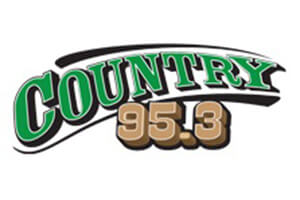
A new FM broadcast station at Pierre, South. Dakota, was authorized November 20, 1979 when the Federal Communications Commission granted Pierre Radio Inc. authorization to operate on 95.3 megacycles with a power of 2.7 KW at an antenna height of 197 feet. The new permittee was owned by William P. Turney and his wife Lanelle (85 percent) and Jerry L. Wolledge and his wife Merillie (15 percent). Mr. Wooledge was a Gann Valley farmer and his wife was a teacher. Estimated construction cost was $5,000; first quarter operating cost was $3,200; while anticipated first year advertising revenue was $50,000. The call letters KNEY (FM) were assigned in late February 1980.
Prior to going on the air, Pierre Radio Inc. sold KNEY (FM) for $1,080 to the Sorenson Broadcasting Corporation on July 29, 1980. The firm was licensee of KCCR at Pierre and was owned by President Dean P. Sorenson (50 percent) and Thomas J. Simmons (50 percent). In 1981, authorized power was increased to 3 KW at an antenna height of 300 feet. Airdate of KNEY (FM) was Wednesday, April 6, 1981 with Mel Moyer it’s General Manager. The new stereo station aired a “middle-of-the-road” music format from offices and studios shared with KCCR at 106 West Capital, Pierre.
In 1982, KNEY (FM) switched to a “Contemporary Music” format. Gary Drake served as General Manager from 1984 – 1988. KNEY (FM) switched to an “Adult Contemporary/Oldies” music format in 1986. Tom Pmlson was named General Manager, from 1988-92. An affiliation with the US One network was added in 1987.
Call letters were changed from KNEY (FM) to KLXS-FM in early April 1988. The station then adopted a fulltime “Oldies Music” format. In 1992, SMN’s “Oldies Music” format was added. Carol Brock succeeded Tom Paulson as General Manager of KCCR and KLXS-FM from 1992-95. An FCC construction permit was issued in 1992 for KLXS-FM to increase power to 50 KW.
Today KLXS-FM is owned by Riverfront Broadcasting LLC. On July 3, 2012 KLXS-FM changed their format from adult hits (as “Jack FM”) to country, branded as “Country 95.3”

On March 1, 1979, the Federal Communications Commission issued a construction permit to the Dakota North Plains Corporation (L. T. Lausten, President and 81.99 percent owner along with five other stockholders) to operate a new AM broadcast station on 910 kilocycles at Volga, South Dakota. While a daytime power of 500 watts was authorized, a night power of 1,000 watts was permitted, using a two pattern (day and night) directional antenna array. Estimated construction cost was $191,555; predicted first year operating cost was $40,000; while $100,000 was anticipated as the station’s first year advertising revenue. Call letters KVAA were assigned in late June 1979 (the firm owned KKAA at Aberdeen.)
KVAA was placed on the air Wednesday, May 6, 1981 from studios located at 605 Kasan, with transmitter and towers near Volga (a town located on U. S. 14, eight miles west of Brookings). David S. Lausten was Vice President of the licensee while General Manager of KVAA was Larry Bauer. The new “MOR” music-formatted station was an affiliate of NBC’s “The Source” young adult network. It aired farm programming 13 1/2 hours weekly. In 1982, KVAA switched to a “Top 40” music format. It’s format became “Adult Contemporary/Country Music” in 1983. Also in 1983, Russell R. McGuire became General Manager.
On May 15, 1985, KVAA was sold by the Dakota North Plains Corporation (L.T. Lausten, President et al) to the Sioux Valley Broadcasting Company (Robert Ingstad, sole owner) for an undisclosed purchase price. Also included was KVAA’s FM sister station, KKQQ (FM). Jeffrey N. Hilborn then became President and General Manager. In mid-May 1985, call letters were changed from KVAA to KJJQ. In 1985, the station affiliated with the ABC Information Radio Network and the regional South Dakota News Network (its liaison with NBC’s “The Source” was then dropped.) In 1985, KJJQ debuted a new full time “Country Music” format.
Today, KJJQ The Ranch, has carved a unique approach, blending News, Sports and Ag/Farm Information with proven country music. We have just the right mix of news and information which is pertinent to not only ag producers, but also a broad based audience. Including updates from the Brownfield Network and NAFB member Susan Littlefield. They also feature the locally originating “Sports Show”, weekdays from 9-11am, focusing on all local/regional sports with guests, special features and some “on-location” broadcasts. The Ranch/KJJQ is also the home of South Dakota State University Jackrabbit Athletics.
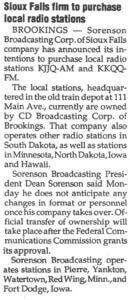
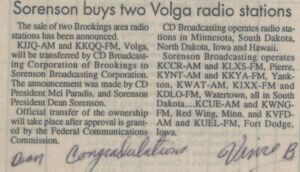
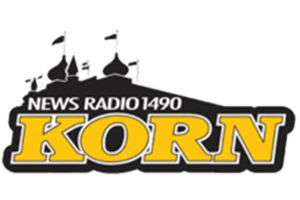
The station is owned by Nancy and Steve Nedved, through licensee Nedved Media, LLC. It airs a News/Sports/Talk radio format. The station offers a mix of local and syndicated programming including shows hosted by Rush Limbaugh, Sean Hannity, Ray Lucia, Jim Bohannon, and “Coast to Coast AM” with George Noory. It also features syndicated sports programing from ESPN Radio and Fox Sports Radio.
The station is the home of the Mitchell High School Kernels sports broadcasts, as well as a member of the Learfield Sports Network, which allows them to air live streams of South Dakota State Jackrabbits sporting events.
The station was originally given the call sign KMHK, and went on the air between August and October 1947. For a few months in late 1950, the station used the call sign KORM. In 1950, after the call letters KORN had been given up by a station in Fremont, Nebraska that had recently become KFGT (and has subsequently become KHUB), the call sign KORN became available and was taken by the former KORM.
Famed radio announcer Gary Owens, of Rowan & Martin’s Laugh-In fame, started his radio career at KORN in 1952, where he served as News Director.
In February 2008, Riverfront Broadcasting LLC of Yankton, South Dakota reached an agreement with NRG Media to purchase this station as part of a six station deal.
In late 2016, Riverfront Broadcasting LLC sold the station, along with sister stations Q107.3, and KORN Country 92.1 to KORN’s General Manager, Nancy Nedved. Effective Sunday, January 1, 2017, the three station group is now known as Nedved Media, LLC.
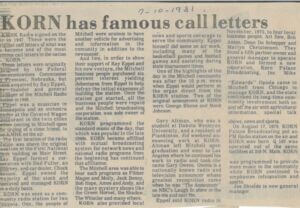
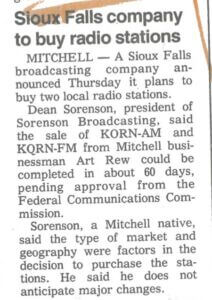
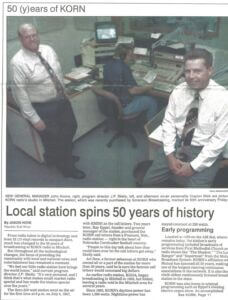
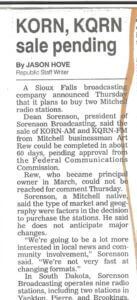

A Construction Permit was granted November 5, 1958 by the Federal Communications Commission for 1590 kilocycles with 1,000 watts daytime hours only at Pierre, South Dakota, to the Great. Plains Broadcasting Corporation. The owners were Daniel C. Lesmeister (then Production Manager at KOTA-TV in Rapid City; Edward N. Davenport (Technical Supervisor, KOTA-TV); Kenneth R. Hankins and Keith R. Hankins (both transmitter supervisors for KOTA-TV) — each holding 25% interest in Great Plains. At last report Lesmeister was with a TV station Texas and Davenport operates an Antique Car Museum in Chadron, Nebraska.
Estimated construction cost for the station was $9,760; first year operating expenses predicted at $30,000; while the first year anticipated revenue was $36,000. Call letters KCCR (for “Capitol City Radio”) were assigned by the FCC in late November. The group was anxious to install “a modern radio station” at Pierre/ the SD state capitol… to join the pioneer KGFX. KGFX, on the air since 1927, was operated by a widow from 9:30 a.m. to 2 p.m., and 4 p.m. to sunset.
Airdate was February 4, 1959. Ed Davenport was President and co-owner, as well as co-General Manager, while Dan Lesmeister was Secretary-Treasurer and co–General Manager. The transmitter was located east of Pierre on SD highway 34, on land owned by Toby Tyler. It’s just east of the Pierre Municipal Golf Course and the Golf Course Housing Development. The tower, a 200 footer, had been purchased and dismantled at the SD School of Mines in Rapid City. Original studios were located in the building housing the Harding Ford Garage…”about 119 West Sioux” in Pierre. The First National Bank is now located on that corner. The founding group sold out in 1960. Acquiring the Great Plains Broadcasting Corporation on April 1, 1960 was Leroy Okerland (originally from Sisseton, a USD Basketball player, who helped the Coleman family put KOLY, Mobridge on the air. Now deceased); Warren May (Pierre Attorney); and one other transferee, paying $40,000. (Charles Burke of Bankwest and former. Federal Judge Don Porter were involved. Both have talked about their involvement). Also a Dr. Holland from Chamberlain was supposedly involved). FCC approval came on March 30th. Mr. Okerland, who at that time, or shortly thereafter, got Great Plains involved with KCOG, Centerville, Iowa, became President. Hank Dais was named General Manager. Studios were moved that year to 331 1/2 S. Pierre. That’s above the Hollywood Shop, a ladies apparel store. Mr. Dais left KCCR in early 1961, and Mr. Okerland also left about that time. M.J. O’Leary (now deceased) was named General Manager.
Warren W. May became President of Great Plains in 1962. W. W. Worley, who came to Pierre from Galesburg, Illinois, was appointed General Manager of KCCR in 1963, and that year the station became affiliated with the Mutual Broadcasting System network. O’Leary had worked out a system of feeding Mutual from KIJV, Huron, to Pierre on leased telegraph lines from Chicago & Northwestern Railroad, on war surplus FM sub-carrier equipment. Names involved with the station during this time were: Scott McIntosh, Shane Siren, Gary Enright, Donna Youngberg, and Jerry Zastrow. The station broadcast from 6:00 a.m. to local sunset.
KCCR was sold by the Great Plains Broadcasting Corporation on May 16, 1964 to Capitol Broadcasting, Inc. Neal P. Edwards (now deceased) was President and 49% owner. Comet W Haraldson (still living in Pierre) was Vice President and 49% owner. Their respective wives each owned 1%. Edwards and Haraldson came from positions at Channel 9-TV (then KXAB-TV, now KABY-TV, Aberdeen). Edwards was General Manager and Haraldson was Chief Engineer. Mike Hatch and Larry Dirksen were familiar names on the staff during this era. KCCR dropped Mutual in late 1964. On February 8, 1965 the FCC issued a change of frequency from 1590 to 1240, kilocycles, fulltime operation. For a short period of time they operated 250 watts day and night, and then in late 1965 were granted approval to raise the day power to 1,000 watts. This was accomplished in 1966.
The change of frequency was accomplished by Edwards and Haraldson working with their Washington attorney, Keith Putbrese. Putbrese put together all the paperwork and filed with the FCC. Then he asked Edwards and Haraldson to use whatever political pull they had. They tried Senior Senator Karl Mundt first, and Mundt politely told them that because of the political climate in Washington at that time he could do nothing, but suggested they try South Dakota’s other Senator, George McGovern. McGovern’s office agreed to help and they would have someone from their office call the FCC every week and check on the progress of the application. Putbrese explained it to Haraldson this way — everytime the Senator’s office would call the FCC, the FCC would search out the application, conveniently move it forward for more immediate consideration…the process worked.
Side-light: As Haraldson and Edwards were preparing the application, across town Dean Sorenson who was running KGFX (200 watts-630kc) had also discovered the 1240 frequency. When KCCR filed, Sorenson abandoned his project, on the basis of the fact the new frequency would increase the KCCR coverage, but decrease the KGFX coverage….therefore KCCR would probably in a contested situation. Later Sorenson moved KGFX to 1060KHz.
Again the station was sold, on August 15, 1968, to Agruss Broadcasting, Inc….for $105,000. Agruss was owned by Nathan Agruss, 50%, and Jordon Ginsburg, 50%. Agruss was President and Ginsburg was Secretary-Treasurer. Agruss was Ginsburg’s father-in-law. Ginsburg was the driving force, and Agruss was never involved in the broadcasting business. Agruss Broadcasting also owned KHAK, Cedar Rapids at that time. The KCCR transfer to Agruss was approved by the FCC on July 31, 1968. Tony Dean (Anthony Dechandt) was Station Manager until March 1970, when he left to become an Aid to Governor Frank Farrar. When Farrar was defeated for re-election in November 1970, Dean became involved in promoting stock car racing, and a series of outdoor shows. He still lives in Pierre and has a national following for his hunting and fishing shows and seminars.
From March 1970 to August 31, 1970, there was a fellow from Iowa who assumed the Management. Our records fail to indicate a name. September 1, 1970 found Dean Sorenson named Manager. From 1962 to 1969, he had been involved in ownership and management of KGFX. He returned to Pierre to run KCCR for Agruss, and almost immediately, KGFX’s Program Director, Fred Smith (Mr. Freddie) joined him. KCCR affiliated with the regional Intermountain Radio Network for sales purposes only. Later IMN provided the ABC Network feed to KCCR. On December 1, 1970, KCCR moved to new offices and studios, at 110 W Capitol. The former 835 square foot Fabric Store gave the station a “street window” control room. This was “home” until December 1975 when the station moved next door to the Hemminger and Sorenson Building at 106 W Capitol.
KCCR was sold March 1, 1972 for $115,000 to Sorenson Broadcasting Corpn., owned 50/50 by Dean Sorenson, the station’s Manager, and Sioux Falls businessman Thomas “Jerry” Simmons. Sorenson then became both President and General Manager. In 1972 KCCR joined the ABC Information Network, remaining an ABC affiliate until 1984 when it switched to CBS.
Names associated with the station during it’s early years of Sorenson ownership were Jim Thompson, Al Quarnstrom, Tom Kearns, Dave Miller, Michala McCue, and Glen Cordes. On July 1, 1973, KCCR Sales Manager, Tom Kearns, left the station to become Manager of KYNT, Yankton, South Dakota, which had just been purchased by Sorenson Broadcasting. Jim Thompson was named Sales Manager.
In 1975 Thompson became Manager. Gerry Norine was hired from KCHF, Sioux Falls to become a Sales Person, and soon was named Sales Manager. June 1, 1976, Sorenson bought another property….KWAT AM/FM, Watertown, South Dakota. Jim Thompson moved to Watertown to manage those stations, and Gerry Norine took over KCCR. Norine left in May 1977, and August 1, 1977, Mel Moyer from KBAB, Indianola, Iowa moved to Pierre and assumed the position. He remained there until November 15, 1984.
In 1975 a new Harris MW-1 Transmitter was installed at the station, making it one of the first all-solid-state radio stations in the Nation. In April 1981, the original transmitter site was abandoned, and moved to Izaak Walton Road, next to the Izaak Walton Clubhouse in Southeast Pierre. A new antenna, ground system, building, remote control, and tuning network gave KCCR the best possible RF Plant. At the same time, it’s new sister-station, KNEY-FM (now KLXS-FM) signed on, at 95.3 MHz on the FM Dial. Pierre’s first FM service….in full stereo.
From November 15, 1984 to 1987, Gary Drake was Manager of KCCR. Drake, a native of Watertown, had been with Sorenson at KWAT & KIXX as Sales Manager. In December 1986, Dean Sorenson redeemed Jerry Simmons 50% interest in Sorenson Broadcasting, thereby owning 100% of the stock.
Today KCCR is currently owned by Riverfront Broadcasting LLC and broadcasts a classic hits music format.

Fred Smith Receives SDBA Award in 1996 Dean Sorenson (L) Fred Smith (R)

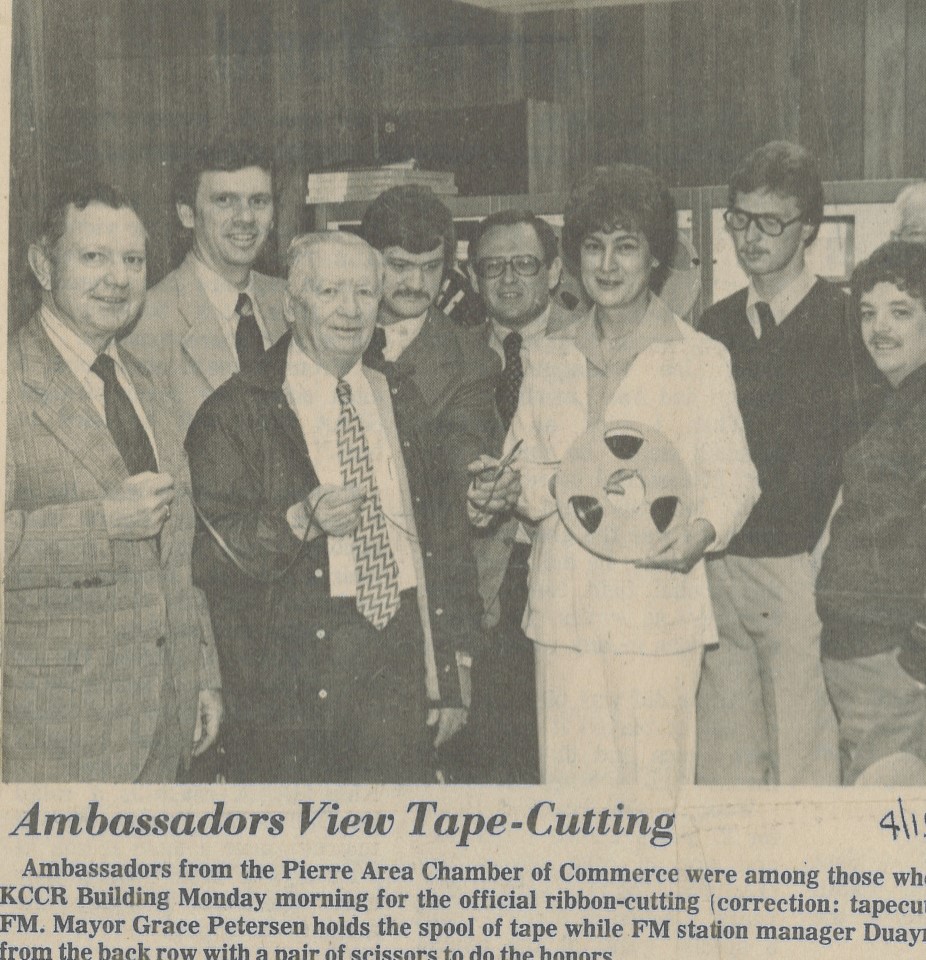
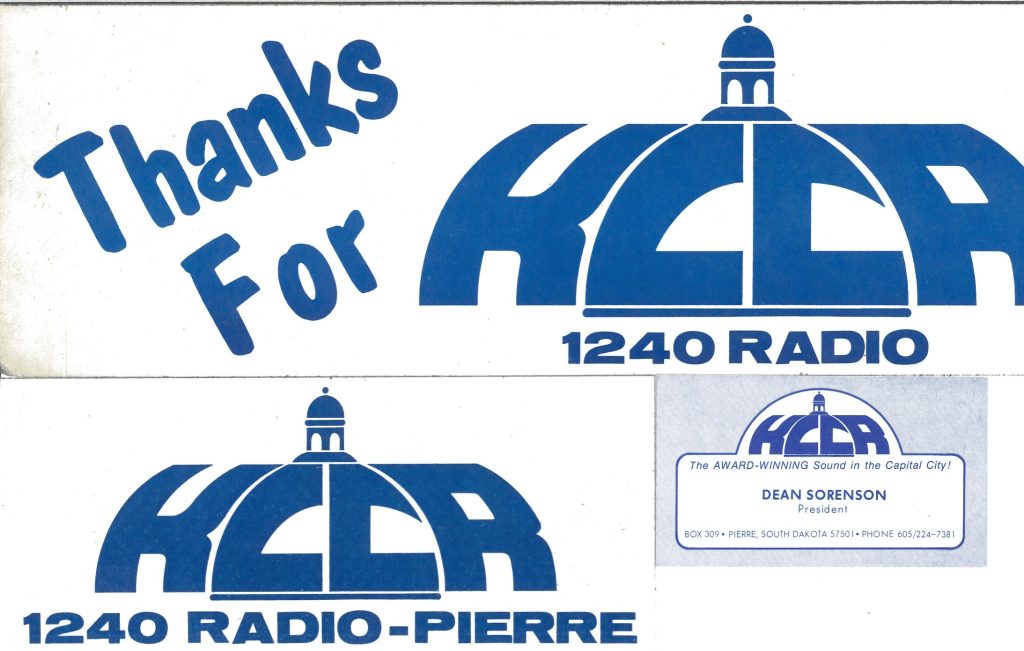

Tom Brokaw Interview 2017:
KYNT BROADCASTING PROFILE
KYNT were call letters assigned to a new Yankton, South Dakota AM broadcast station, authorized January 27, 1955 to the Yankton Broadcasting Company (William M Smith, President and Treasurer –with 40% interest — in real estate development; Doris J. Smith, Vice President — 56% interest; and James L. Cope, Secretary, a local attorney, with 4% interest. The Federal Communications Commission authorized 250 watts unlimited hours and 1450 kilocycles for the new station. Estimated construction costs for KYNT were $20,622; expected first year operating expenses of $42,000; with revenues of $52,000 predicted.
From studios at 214 West Third Street, Yankton, KYNT first went on the air Tuesday March 15, 1955 with William M. Smith it’s President and William E. Johnson it’s Station Manager. The station was originally an independent outlet. KYNT was granted it’s first FCC license March 22, 1955. William E. Johnson in 1956 assumed the position of Executive Vice President and Station Manager of KYNT. Studios in downtown Yankton were closed in 1958 with the station moving to Mr. Smith’s Kochi Motel complex one mile east and one mile north of the station’s transmitting site on North Highway 81.
The Yankton Broadcasting Company (William M. Smith, President at al) sold KYNT for $179,400 to Leon T. Scoblic and Lloyd G. Reedstrom, equal partner, in a sale gaining FCC sanction May 18, 1960 with the new owners, both in the office equipment business, assuming control May 24th. Mr. Reedstrom was the station’s new General Manager, and in 1960, all operations shifted to the station’s tower site on North Highway 81. The station affiliated in 1962 with the nationwide Mutual Broadcasting System radio network. By mid 1964, the station, airing a “Block Variety” program format, was in daily operation from 6:00 a. m. to 12:00 midnight (Sunday sign-on two hours later).
Daytime power rose from 250 to 1,000 watts in 1965 with nighttime power remaining at the 250 watt level. By 1971, KYNT was programming a “Middle-Of-The-Road” music format. An affiliation with the InterMountain Network was secured in 1971 with the station’s liaison with Mutual continuing, KYNT was sold by co-owners L. T. Scoblic and General Manger Lloyd G. Reedstrom to the Sorenson Broadcasting Corporation on July 1, 1973. Dean P. Sorenson was president and fifty percent owner while the remaining equal interest was held by Thomas J. Simmons. On June 19, 1973, the FCC approved this $235,000 sale. Mr. Sorenson then became President of KYNT, and named Tom Kearns to the post of General Manager. The Yankton station was the pairs second station, joining KCCR in Pierre, South Dakota, also co-owned by Mr. Sorenson and Jerry Simmons, owner of Jerry Simmons an Associates of Sioux Falls. The station adopted a “MOR” music format during the daytime hours and a “Contemporary” music format at night by the end of 1973. In 1974, KYNT dropped it’s IMN affiliation but remained with the Mutual Broadcasting System network. A new “Adult MOR/News and Information” program format was instituted in 1978. The station switched affiliation to the ABC Information Radio Network in early 1982.
Today KYNT is owned and licensed by Riverfront Broadcasting LLC It airs a Soft Adult Contemporary format.
Television History

The station debuted on July 31, 1960 as KSOO-TV, the third station in Sioux Falls. It was owned by the South Dakota Broadcasting Company along with KSOOradio and was an NBC affiliate with a secondary ABC affiliation. From 1960 to 1969, it operated as the flagship of a regional network with separately-owned KORN-TV in Mitchell (channel 5, now KDLT-TV on channel 46). KSOO-TV served the eastern portion of the market, while KORN-TV served the western portion. In 1969, the Federal Communications Commission forced the breakup of this network, and KSOO-TV became the sole NBC affiliate.
In 1970, it bought KXAB-TV in Aberdeen to boost its coverage in northeastern South Dakota. As part of the sale, KXAB’s calls changed to KCOO-TV. The two stations were bought by Forum Publishing Company of Fargo, North Dakota in 1975 and switched their call letters respectively to the current KSFY and KABY. KPRY-TV in Pierre was added a year later in 1976. In 1983, KSFY swapped affiliations with channel 5, then recently renamed KDLT and became an ABC affiliate. ABC was the top-rated network at the time and wanted to be on a stronger station. Additionally, KSFY had three full-power transmitters to KDLT’s one, and Forum’s flagship stations WDAY and WDAZ in the eastern part of North Dakota were also converting to ABC affiliations at the same time.
Forum sold the KSFY stations to Aflac in 1985. Aflac sold its broadcasting division to Retirement Systems of Alabama in 1996, who merged it with Ellis Communications to form Raycom Media. In 2004, Raycom sold the KSFY stations to The Wicks Group of Companies.
Hoak Media bought KSFY and its satellite stations in July 2006, as well as KVLY-TV and KXJB-TV (LMA with Catamount Broadcasting) of Fargo and KFYR-TV of Bismarck, North Dakota and its satellite stations. The sale was approved by the FCC on November 17, 2006. On November 20, 2013, Hoak announced the sale of most of its stations, including KSFY and its satellites to Gray Television. The sale was completed on June 13, 2014.

KELO signed on air on May 19, 1953 as South Dakota’s first television station. It was owned by Midcontinent Media, a theater and broadcasting conglomerate, along with KELO radio (AM 1320 and 92.5 FM). It was a primary NBC affiliate, but it also carried programs from ABC, CBS and DuMont. After KSOO-TV (now KSFY-TV) signed on in 1960, KELO switched its primary affiliation to CBS and has remained with that network ever since.
Shortly after KELO signed on, the Federal Communications Commission collapsed eastern South Dakota, southwestern Minnesota and northwest Iowa into one giant television market. Later in the 1950s, Midcontinent began signing on satellite stations of KELO to serve its vast coverage area. KDLO in Florence was the first of the satellite stations to go on the air on September 27, 1955; followed by KPLO, licensed to Reliance and serving South Dakota’s state capitol of Pierre on July 15, 1957.
KELO expanded to western South Dakota in 1981, when it signed on K15AC (channel 15), a translator of KPLO-TV, to serve Rapid City. On November 28, 1988, it was upgraded to a full-powered semi-satellite as KCLO. Rapid City had been one of the few areas of the country without full service from the three major networks.
KELO was home to Captain 11, a popular children’s show in the area, from 1955 until 1996. Captain 11 was Dave Dedrick, the station’s longtime weatherman. He had been a popular radio personality before KELO went on air.
Channel 11 originally broadcast from a 575-foot (175 m) tower near Shindler, South Dakota. On September 20, 1955, it was destroyed in a severe windstorm–believed to be a tornado. Station engineers had the station back on the air in 48 hours—just in time for the World Series. In 1956, the station erected a 1,032-foot (315 m) tower on the same site, expanding its coverage area to most of eastern South Dakota. In 1967, KELO moved to a new 2,032-foot (619 m) tower near Rowena, shared with KSFY. The Shindler tower is still used as a backup.
On June 24, 1968; a North Central airliner clipped a guy wire on the year-old Rowena tower, bringing it down. Luckily, the plane landed safely with no injuries. KELO engineers had the station back on the air in three days from the old tower in Shindler. The Rowena tower was quickly rebuilt.
On January 11, 1975, the KELO tower was destroyed by a powerful winter storm. Within hours, the station was back on the air from Shindler. The tower was again rebuilt at Rowena and became operational on December 19, 1975. The Rowena site is sometimes called the “Bermuda Triangle” of tower sites due to the numerous collapses.
In the years that followed, KDLO’s tower collapsed and KELO lost other microwave and translator sites to storms and other reasons. KPLO’s tower collapsed on January 22, 2010 in a severe ice storm. It returned to the air on March 19, 2010. For a time, however, it operated at low power, leaving Pierre without an over-the-air signal. The FCC subsequently issued a construction permit for a low-powered fill-in translator on channel 29 in Pierre.
On November 25, 1986, KELO began broadcasting its programming in stereo. In 1995, Midcontinent Media sold KELO to Young Broadcasting; the sale was approved by the Federal Communications Commission on May 31, 1996. The station celebrated its 50th anniversary on May 19, 2003.
On June 6, 2013, Young Broadcasting announced that it would merge with Media General. The merger was approved on November 8, after Media General shareholders approved the merger a day earlier; it was completed on November 12.
